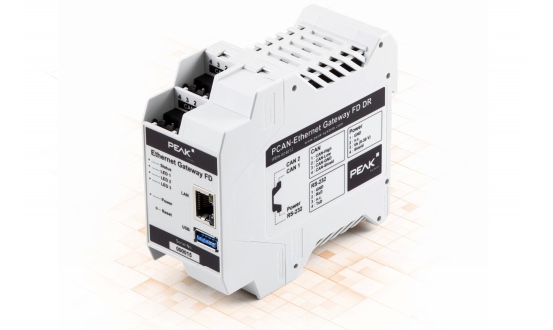Recent Posts
CAN FD To Ethernet Gateway With Linux Operating System
Posted by on
The PCAN-Gateway series from PEAK System supports the transmission of CAN Bus data frames over IP networks. The PCAN-Ethernet Gateway FD DR supports CAN FD in addition to the Classical CAN Bus Standard.
Both CAN Bus interfaces are CAN FD compliant with data bit-rates of up to 10 Mbit/s. An AM5716 Sitara processor provides the required performance for the CAN Bus and Ethernet port. In cases where a CAN network utilizes a PCAN-Ethernet Gateway FD DR, the LAN interface is fully capable of accessing the CAN network with one or more computers. A conventional CAN Bus interface is not required. An application with two gateways allows the connection of separate CAN Bus networks via an IP network, thus eliminating the restriction that comes with the maximum physical CAN Bus length.
A standard Internet router allows the configuration of the products via a web interface, including status information and communication settings, message forwarding, and filters. Alternatively, a JSON interface provides access via software.
CAN to Ethernet Gateway Specifications
- AM5716 Sitara with Arm® Cortex® M15 core
- 2 GByte Flash and 1 GByte DDR3 RAM
- Linux operating system (version 4.19)
- Two High-speed CAN channels (ISO 11898-2)
- Compliant with CAN specifications 2.0 A/B and FD
- CAN FD bit rates for the data field (64 bytes max.) from 20 kbit/s up to 10 Mbit/s
- CAN bit rates from 20 kbit/s up to 1 Mbit/s
- Microchip MCP2558FD CAN transceiver
- Galvanic isolation of the CAN Bus channels up to 500 V against each other, against RS-232, and the power supply
- Connections for CAN Bus, RS-232, and power supply via 4-pole screw-terminal strips (Phoenix)
- LAN interface
- Data transmission using TCP or UDP
- 10/100/1000 Mbit/s bit rate
- RJ-45 connector with status LEDs
- Monitoring and configuration of the devices via the web interface or JSON interface
- Software update via the web interface
- Reboot or reset of the device to a previous software version with a reset button
- Plastic casing (width: 45.2 mm) for mounting on a DIN rail (DIN EN 60715 TH35)
- LEDs for device status and power supply
- PCI Express Mini slot, USB port, and a RS-232 connector for future use
- Voltage supply from 8 to 30 V
- Operating temperature range from -40 to 70 °C (-40 to 158 °F)
- Fan for active cooling when a temperature limit is exceeded
Teensy 4.1 Triple CAN Bus Board with 240x240 LCD and Ethernet
This is a Teensy 4.1 board with triple CAN connections, two CAN 2.0B and one CAN FD, and ethernet magjack. It can be powered by an external +12 VDC with reverse voltage protection. Included is also a 240x240 wide angle IPS TFT LCD display.
The Teensy 4.1 is an Arduino-compatible board with an Arm Cortex-M7 microcontroller running at 600 MHz. The board is compatible with the Arduino IDE and the Arduino library. In most cases, code written for another Arduino board works with a minimum of changes on a Teensy. As the name implies, the board is tiny. For example, the current form factor is only about 18 by 36 millimeters. However, do not let the size mislead you; these boards pack a ton of functionality. For example, the new Teensy 4.1 features a megabyte of RAM, two megabytes of Flash, a bevy of I/O options, cryptographic support, a hardware floating-point processor (FPU), and a built-in real-time clock (RTC).
 Loading... Please wait...
Loading... Please wait...


